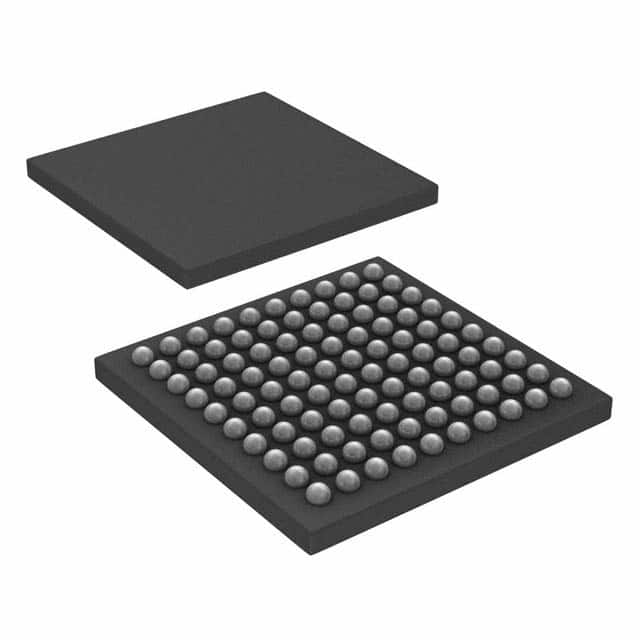AT91SAM7XC128-CU
Product Overview
- Category: Microcontroller
- Use: Embedded systems, Internet of Things (IoT) devices, industrial automation
- Characteristics: High-performance, low-power consumption, extensive peripheral set
- Package: LQFP (Low-profile Quad Flat Package)
- Essence: ARM-based microcontroller with 128KB Flash memory and 64KB SRAM
- Packaging/Quantity: Available in tape and reel packaging, quantity depends on manufacturer
Specifications
- Microcontroller Core: ARM7TDMI-S
- Clock Speed: Up to 55 MHz
- Flash Memory: 128KB
- SRAM: 64KB
- Operating Voltage: 1.65V to 3.6V
- Operating Temperature: -40°C to +85°C
- Digital I/O Pins: 53
- Analog Input Channels: 8
- Serial Communication Interfaces: USART, SPI, TWI (I2C)
- Timers/Counters: 4 x 16-bit, 1 x 8-channel PWM
- Analog-to-Digital Converter (ADC): 10-bit resolution, up to 8 channels
- Power Supply: Single power supply, voltage regulator included
Detailed Pin Configuration
The AT91SAM7XC128-CU microcontroller has a total of 100 pins. The pin configuration is as follows:
- Pins 1-20: Digital I/O pins
- Pins 21-28: Analog input pins
- Pins 29-36: Serial communication interface pins (USART)
- Pins 37-44: Serial Peripheral Interface (SPI) pins
- Pins 45-52: Two-Wire Interface (TWI/I2C) pins
- Pins 53-56: Timer/Counter pins
- Pins 57-64: PWM (Pulse Width Modulation) pins
- Pins 65-72: Analog-to-Digital Converter (ADC) pins
- Pins 73-100: Ground, power supply, and other control pins
Functional Features
- High-performance ARM7TDMI-S core for efficient processing
- Extensive peripheral set for versatile applications
- Low-power consumption for energy-efficient designs
- Flexible clocking options for optimized performance
- Built-in voltage regulator for simplified power supply design
- Multiple serial communication interfaces for easy connectivity
- Analog-to-Digital Converter (ADC) for precise analog measurements
- Timers and counters for accurate timing and event counting
- PWM channels for generating analog-like signals
Advantages and Disadvantages
Advantages
- Powerful microcontroller core for efficient processing
- Wide range of peripherals for diverse application requirements
- Low-power consumption for energy-efficient designs
- Flexible clocking options for optimized performance
- Easy connectivity with multiple serial communication interfaces
- Precise analog measurements with the built-in ADC
- Accurate timing and event counting with timers and counters
- PWM channels for generating analog-like signals
Disadvantages
- Limited Flash memory and SRAM compared to some other microcontrollers
- Relatively higher cost compared to lower-end microcontrollers
- Steeper learning curve for beginners due to advanced features
Working Principles
The AT91SAM7XC128-CU microcontroller operates based on the ARM7TDMI-S core architecture. It executes instructions fetched from the Flash memory and interacts with various peripherals to perform desired tasks. The clock speed determines the rate at which instructions are executed.
The microcontroller can be programmed using a variety of development tools and programming languages. The code is typically written in a high-level language, compiled, and then loaded onto the microcontroller's Flash memory. During operation, the microcontroller executes the code and interacts with external devices through its peripheral interfaces.
Detailed Application Field Plans
The AT91SAM7XC128-CU microcontroller finds applications in various fields, including:
- Industrial Automation: Control systems, motor control, process monitoring
- Internet of Things (IoT): Sensor nodes, smart home devices, wearable technology
- Automotive: Engine management, dashboard displays, infotainment systems
- Consumer Electronics: Home appliances, gaming consoles, audio/video equipment
- Medical Devices: Patient monitoring, diagnostic equipment, medical imaging
Alternative Models
There are several alternative models available that offer similar functionality to the AT91SAM7XC128-CU microcontroller. Some popular alternatives include:
- STM32F407VG: ARM Cortex-M4 core, 1MB Flash, 192KB SRAM
- PIC32MX795F512L: MIPS32 core, 512KB Flash, 128KB RAM
- LPC1768: ARM Cortex-M3 core, 512KB Flash, 64KB SRAM
Lista 10 Vanliga frågor och svar relaterade till tillämpningen av AT91SAM7XC128-CU i tekniska lösningar
Sure! Here are 10 common questions and answers related to the application of AT91SAM7XC128-CU in technical solutions:
Q: What is the AT91SAM7XC128-CU microcontroller used for? A: The AT91SAM7XC128-CU microcontroller is commonly used in various technical solutions, including industrial automation, robotics, embedded systems, and IoT applications.
Q: What is the maximum clock frequency supported by the AT91SAM7XC128-CU? A: The AT91SAM7XC128-CU supports a maximum clock frequency of 55 MHz.
Q: How much flash memory does the AT91SAM7XC128-CU have? A: The AT91SAM7XC128-CU has 128 KB of on-chip flash memory.
Q: Can I expand the memory of the AT91SAM7XC128-CU? A: Yes, the AT91SAM7XC128-CU supports external memory expansion through its external bus interface.
Q: What peripherals are available on the AT91SAM7XC128-CU? A: The AT91SAM7XC128-CU offers various peripherals, including UART, SPI, I2C, ADC, PWM, timers, and GPIO pins.
Q: Does the AT91SAM7XC128-CU support USB connectivity? A: Yes, the AT91SAM7XC128-CU features a USB 2.0 full-speed device port.
Q: Can I use the AT91SAM7XC128-CU for real-time applications? A: Yes, the AT91SAM7XC128-CU includes a real-time timer (RTT) and supports interrupt handling, making it suitable for real-time applications.
Q: What development tools are available for programming the AT91SAM7XC128-CU? A: The AT91SAM7XC128-CU can be programmed using various development tools, such as Atmel Studio, Keil MDK, and IAR Embedded Workbench.
Q: Is the AT91SAM7XC128-CU compatible with other microcontrollers or development boards? A: Yes, the AT91SAM7XC128-CU is part of the AT91SAM7X family and is compatible with other microcontrollers in the same series. It can also be used with compatible development boards.
Q: Where can I find documentation and resources for the AT91SAM7XC128-CU? A: Documentation, datasheets, application notes, and other resources for the AT91SAM7XC128-CU can be found on the official website of the microcontroller's manufacturer, as well as on various online forums and communities dedicated to embedded systems development.


